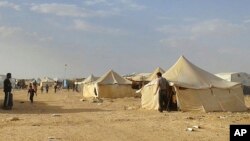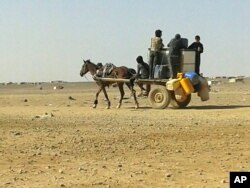As freezing temperatures start to bite in the war-torn Middle East region, tens of thousands of Syrian refugees, stranded along the Syrian side of the border with Jordan, have been thrown a lifeline by the Hashemite Kingdom.
On Tuesday, Jordanian authorities announced the resumption of aid to tens of thousands of people, half of them children, who have been stuck in squalid conditions with little food, water, medical care and other necessities since Jordan closed the border on June 21 to Syrian refugees fleeing their war-torn country.
That followed the killing of seven Jordanian soldiers reportedly by Islamic State militants. Since then, Jordan has allowed only one delivery of aid, back in August, to the refugees forced to stay on a remote, barren strip of no-man's land.
“We are very happy that we can resume now the operation,” said Jens Laerke, spokesman for the U.N. Coordination of Humanitarian Affairs. “It is a lifeline to the 85,000 people. I believe three-quarters of them are women and children, who are stranded there in this remote, arid area.”
Food, other aid delivered Tuesday
Laerke told VOA that food and essential items were delivered on Tuesday to some 170 households in the Rukban community in preparation for the winter months. He noted that this was the beginning of a planned two-week distribution cycle and in the coming days other relief, as well as health care services, would be provided.
Aid has begun to flow to the refugees from different U.N. agencies. For example, the U.N. Children's Fund has been distributing warm sweaters, trousers, jackets, hats, gloves, scarves, socks and boots to children under age one, as well as warm winter clothing for older children.
The agency, which has delivered safe water to the refugees on a daily basis since the border was closed in June, plans to provide hygiene kits, along with other non-food items.
Winter weather a major concern
UNICEF spokesman Christophe Boulierac said that aid workers have not yet had a chance to assess the condition of the refugees, but according to unconfirmed reports, there has been “an increase in malnutrition and rise in preventable diseases” among the children and women.
“There are also children with disabilities at about 2- to 3-percent and many unaccompanied and separated children.” He said UNICEF was extremely concerned about the welfare of children, particularly during the bitter cold winter months when “children will be more susceptible to acute respiratory infections and other winter-related conditions.”
He said UNICEF was establishing a so-called mobile health and nutrition caravan to provide primary health care services. “Discussions are ongoing with the Jordan Armed forces for access to children and individuals requiring urgent medical support,” he said.
Warm clothing, blankets
With the onset of winter, the U.N. refugee agency has expanded its winter assistance program throughout Syria and the region. The agency said it aimed to reach 3.2 million internally displaced Syrians and refugees and 1.4 million displaced Iraqis within Syria and Iraq, as well as in Turkey, Jordan, Lebanon and Egypt.
The UNHCR said its humanitarian operation included a mixture of cash payments to people in need, along with the distribution of warm clothing, blankets, heating fuel and other necessities to help people survive the harsh winter.
While there are plans to assist more than 292,000 vulnerable Syrians and nearly 30,000 Iraqis and other nationalities in Jordan, a UNHCR spokesman, Matthew Saltmarsh, told VOA that the agency's winterization plan did not include the border area where the Syrian refugees were stranded.
'Challenging' operation
“We have not had access until now and we have been negotiating with the Jordanian authorities to obtain that access.
"This is one of the most challenging humanitarian operations in the world today and UNHCR and other agencies would like to extend their thanks to the government of Jordan for making the operation possible."
He said that he understood the security constraints that obliged authorities to stop aid to the area some months ago. Nevertheless, he said, "Overall, we are hopeful and confident that this will be the start of sustained, better access to the area."










